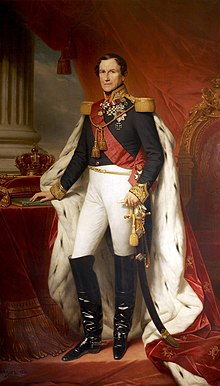
Back Leopold I van België Afrikaans ليوبولد الأول ملك بلجيكا Arabic ليوبولد الاول ملك بلجيكا ARZ Leopoldu I de Bélxica AST بیرینجی لئوپولد (بلژیک) AZB Леапольд I (кароль Бельгіі) Byelorussian Леополд I (Белгия) Bulgarian Leopold Iañ (Belgia) Breton Leopold I, kralj Belgijanaca BS Leopold I de Bèlgica Catalan
| Leopold I | |||||
|---|---|---|---|---|---|
 Portrait, 1856 | |||||
| King of the Belgians | |||||
| Reign | 21 July 1831 – 10 December 1865 | ||||
| Predecessor | Erasme Louis Surlet de Chokier (as Regent of Belgium) | ||||
| Successor | Leopold II | ||||
| Prime Ministers | |||||
| Born | Prince Leopold of Saxe-Coburg-Saalfeld 16 December 1790 Ehrenburg Palace, Coburg, Saxe-Coburg-Saalfeld, Holy Roman Empire | ||||
| Died | 10 December 1865 (aged 74) Castle of Laeken, Brussels, Belgium | ||||
| Burial | |||||
| Spouses | |||||
| Issue |
| ||||
| |||||
| House |
| ||||
| Father | Francis, Duke of Saxe-Coburg-Saalfeld | ||||
| Mother | Countess Augusta Reuss of Ebersdorf | ||||
| Religion | Lutheran | ||||
| Signature |  | ||||
| Military career | |||||
| Allegiance | |||||
Leopold I (French: Léopold; 16 December 1790 – 10 December 1865) was the first King of the Belgians, reigning from 21 July 1831 until his death in 1865.
The youngest son of Francis, Duke of Saxe-Coburg-Saalfeld, Leopold took a commission in the Imperial Russian Army and fought against Napoleon after French troops overran Saxe-Coburg during the Napoleonic Wars. After Napoleon's defeat, Leopold moved to the United Kingdom, where in 1816 he married Princess Charlotte of Wales, the only child of the Prince Regent (the future King George IV). Leopold and Charlotte's marriage was happy, but it ended after a year and a half when Charlotte died after delivering a stillborn son. Leopold continued to enjoy considerable status in Britain.
After the Greek War of Independence (1821–1830), Leopold was offered the throne of Greece under the 1830 London Protocol that created an independent Greek state, but turned it down, believing it to be too precarious. Instead, he accepted the throne of Belgium in 1831 following the country's independence in 1830. The Belgian government offered the position to Leopold because of his diplomatic connections with royal houses across Europe, and because as the British-backed candidate, he was not affiliated with other powers, such as France, which were believed to have territorial ambitions in Belgium which might threaten the European balance of power created by the 1815 Congress of Vienna.
Leopold took his oath as King of the Belgians on 21 July 1831, an event commemorated annually as Belgian National Day. The following year, he married Princess Louise of Orléans, with whom he had four children: Louis Philippe, Leopold, Philippe, and Charlotte. The King had another two sons, George and Arthur, by his mistress Arcadie Meyer. Leopold's reign was marked by attempts by the Dutch to recapture Belgium and, later, by internal political division between liberals and Catholics. As a Protestant, Leopold was considered liberal and encouraged economic modernisation, playing an important role in encouraging the creation of Belgium's first railway in 1835 and subsequent industrialisation. As a result of the ambiguities in the Belgian Constitution, Leopold was able to slightly expand the monarch's powers during his reign. He also played an important role in stopping the spread of the Revolutions of 1848 into Belgium. He died in 1865 and was succeeded by his son Leopold II.
© MMXXIII Rich X Search. We shall prevail. All rights reserved. Rich X Search